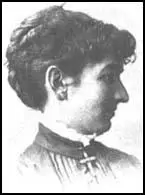Ellen Gates Starr

Ellen Gates Starr was born in Laona, Illinois, in 1859. Starr was a student at the Rockford Female Seminary (1877-78) where she met Jane Addams. Starr taught for ten years in Chicago before joining Addams in 1888 of a tour of Europe. While in London they visited Toynbee Hall. Inspired by the success of this project, they became determined to establish a similar social settlement in Chicago.
When Addams and Starr returned to Chicago in 1889, they purchased a large dilapidated mansion formerly owned by the wealthy businessman, Charles J. Hull. Hull House was opened as a kindergarten but soon expanded to include a day nursery, an infancy care centre and further education classes. Starr and Addams were later joined by other social reformers such as Edith Abbott, Grace Abbott, Florence Kelley, Julia Lathrop, Alice Hamilton, Mary McDowell, Alzina Stevens and Sophonisba Breckinridge at the settlement.
As well as teaching at Hull House Starr was active in the campaign to reform child labour laws and industrial working conditions in Chicago. Starr, a member of the Women's Trade Union League, she helped organize striking garment workers in 1896, 1910 and 1915.
In 1930 Ellen Gates Starr retired to a Roman Catholic convent in Suffern, New York County, where she died on 10th February, 1940.
Primary Sources
(1) Nora Marks, Chicago Tribune (19th May, 1890)
Miss Jane Addams and Miss Ellen Starr got tired of keeping their culture, and wealth, and social capacity to themselves. These young women believe that all luxury is right that can be shared. They have taken their books, pictures, learning, gentle manner, esthetic taste, to South Halsted Street.
Monday afternoon a club of young women meets and read Romola, aided by pictures of Florence, contemporary art, and lectures by Miss Starr on Florentine artists.
There is a wide, bright livery stable at No. 331 South Halsted Street that could be secured for a moderate rental. Skylights could be put in and the brick walls decorated. Then it could be be a gallery for loan exhibits, a studio for instruction, a dance-hall.
"Why not?" says Miss Starr. "The worst thing about these crowded districts is the fact of there being no private places for dancing. Young people will dance. These people cannot do it in private houses - hence public balls. Why not a dance where the amusement could be indulged in innocently and without danger?"
(2) Ellen Gates Starr, letter to Mary Blaisdell (18th May, 1890)
The article in the Chicago Tribune (about Hull House) was disgustingly vulgar and horrid. There were some consolations - she didn't call the neighborhood "slums". The worst thing was her saying at the end, of the college extension it will be greater than any charity. Why she wanted to slap it in the face by comparing it with a charity, I can't grasp.
Now comes the great item of news. Miss Culver has given us the house rent free for four years, amounting to $2800 and we have decided to call the house Hull House.
(3) Mary Kenney wrote about Ellen Gates Starr and Hull House in her unpublished autobiography.
Miss Starr I quickly learned to love dearly. She had a sense of humour unequaled by anyone I'd ever known. At my first appearance in Hull House, she seemed to sense my defiance and laughed. I was sensitive and I gave her a cold stare.
When I went to live in Hull House I tried to ignore Miss Starr, but she came to me, and after we talked things over, we became friends. It was a great privilege to have her as a friend. She was like an older sister. When I made mistakes, she "took me in hand," and she wasn't afraid to tell me just what she thought.
